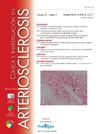The mechanisms underlying the cardiac effects of modified citrus pectin in obese rats with myocardial ischemia: Role of galectin-3
IF 1.9
Q3 PERIPHERAL VASCULAR DISEASE
引用次数: 0
Abstract
Background
Modified citrus pectin (MCP) is used as a nutritional supplement that inhibits galectin-3 activity, a central player in the cardiac damage associated with different pathological situations. In fact, we have previously observed that MCP improved cardiac function in obese infarcted rats that was associated with a reduction in cardiac fibrosis. Therefore, the aim of the present study was to further explore whether this effect could involve the modulation of gene expression of ECM components and their mediators as well as whether it could affect another two mechanisms involved in cardiac damage: mitochondrial dynamics and autophagic flux.
Methods
Male Wistar rats were fed an atherogenic diet with a high content of saturated fat (35%). MI was induced by the ligation of left anterior descendant (LAD) coronary artery 6 weeks after and MCP (100 mg/kg/day) or vehicle were administered for 4 weeks more. A group of rats fed a standard diet (5.3% fat) and subjected to a sham operation was used as controls.
Results
Obese infarcted animals presented an increase in cross-linked collagen that was not affected by the administration of galectin-3 inhibitor. However, MCP reduced the increase in gene expression observed in obese infarcted rats of ECM components and mediators (collagen I, fibronectin, transforming growth factor-β and connective tissue growth factor), of components of endoplasmic reticulum stress (binding immunoglobulin protein, CCAAT-enhancer-binding homologous protein and activating transcription factor 4), of oxidative stress mediator (NADPH oxidase-4) and normalized those of the interleukin 33/ST2 system. MCP is also able to increase the levels of the mitochondrial protein Dynamin-1-like and those of both proteins involved in autophagic flux (p62 and LC3) that were reduced by the myocardial ischemia in the context of obesity.
Conclusions
The data show that the beneficial effect of the nutritional supplement MCP on the cardiac consequences associated with myocardial ischemia in the context of obesity could rely on its capacity to inhibit galectin-3 and to consequently modulate different downstream mechanisms, including inflammation, ER stress, oxidative stress, autophagy and mitochondrial function, which can facilitate fibrosis and cardiac remodeling in this pathological context.
改良柑橘果胶对心肌缺血肥胖大鼠心脏作用的机制:半乳糖凝集素-3的作用。
背景:改性柑橘果胶(MCP)被用作抑制半乳糖凝集素-3活性的营养补充剂,半乳糖凝集素-3是与不同病理情况相关的心脏损伤的核心参与者。事实上,我们之前已经观察到MCP改善了肥胖梗死大鼠的心功能,这与心脏纤维化的减少有关。因此,本研究的目的是进一步探讨这种作用是否涉及ECM成分及其介质的基因表达调节,以及它是否会影响涉及心脏损伤的另外两种机制:线粒体动力学和自噬通量。方法:给雄性Wistar大鼠喂食饱和脂肪含量高(35%)的致动脉粥样硬化饮食。6周后结扎左前后代冠状动脉(LAD)诱导心肌梗死,再给予MCP (100mg/kg/天)或载药4周。一组大鼠喂食标准饮食(5.3%脂肪)并进行假手术作为对照。结果:肥胖梗死动物表现出交联胶原蛋白的增加,而这种胶原蛋白不受半乳糖凝集素-3抑制剂的影响。然而,MCP降低了肥胖梗死大鼠ECM成分和介质(胶原I、纤维连接蛋白、转化生长因子-β和结缔组织生长因子)、内质网应激成分(结合免疫球蛋白蛋白、ccaat增强子结合同源蛋白和激活转录因子4)、氧化应激介质(NADPH氧化酶-4)的基因表达增加,并使白细胞介素33/ST2系统的基因表达正常化。MCP还能够增加线粒体蛋白dynamin -1样蛋白和参与自噬通量的蛋白(p62和LC3)的水平,这些蛋白在肥胖的情况下因心肌缺血而降低。结论:数据显示,营养补充剂MCP对肥胖背景下心肌缺血相关心脏后果的有益作用可能依赖于其抑制半乳糖凝集素-3的能力,从而调节不同的下游机制,包括炎症、内质网应激、氧化应激、自噬和线粒体功能,这些机制可以促进纤维化和心脏重塑。
本文章由计算机程序翻译,如有差异,请以英文原文为准。
求助全文
约1分钟内获得全文
求助全文
来源期刊

Clinica e Investigacion en Arteriosclerosis
PERIPHERAL VASCULAR DISEASE-
CiteScore
3.20
自引率
6.20%
发文量
44
审稿时长
40 days
期刊介绍:
La publicación idónea para acceder tanto a los últimos originales de investigación como a formación médica continuada sobre la arteriosclerosis y su etiología, epidemiología, fisiopatología, diagnóstico y tratamiento. Además, es la publicación oficial de la Sociedad Española de Arteriosclerosis.
 求助内容:
求助内容: 应助结果提醒方式:
应助结果提醒方式:


